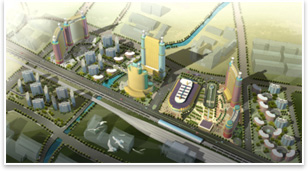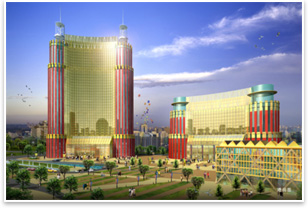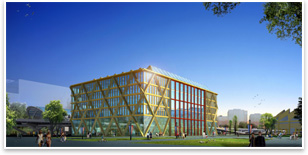Master Plan for Wuxi, China, Aims to Create an Urban Nucleus
by Russell Boniface
Associate Editor
Summary: Wuxi, China (pronounced Wuhsi), an old industrial city densely populated and highly cultured, recently has been dubbed "Little Shanghai" because of its surge in recent redevelopment. As part of this surge, Chicago-based Cordogan, Clark & Associates developed a conceptual master plan for a new district in the city, the Wuxi Transportation Center, which creates a modern "compact city” with forms of Chinese architecture. John Clark, AIA, partner and principal-in-charge of the project, says that although drawing the plan was a fantasy, there will in fact be discussions next month with China about potentially making the land ready for development. Will the Wuxi project be an example of fantasy becoming reality?
 Wuxi, which sits along China's eastern coast, originally was a mining town. It later became an arts and cultural center, and currently has a revitalized economy—one of the best in China—through two industrial parks focusing on textiles. Wuxi also serves as a central transportation hub in the region. Wuxi, which sits along China's eastern coast, originally was a mining town. It later became an arts and cultural center, and currently has a revitalized economy—one of the best in China—through two industrial parks focusing on textiles. Wuxi also serves as a central transportation hub in the region.
A modern "compact city" within a park
The Wuxi Transportation Center concept prepared by Cordogan, Clark & Associates would sit within the city limits. The 10-city-block, 27-million-square-foot plan would feature hotel, retail, and residential buildings in an urban park. Decreased site density would provide open green space and a river walk development, while curved buildings would flank the development as enormous gateways. To preserve Chinese architectural forms, John Clark and his team incorporated traditional colors of red, gold, and yellow with the philosophical concept of yin-yang and the ancient practice of feng shui—the arrangement of space to achieve harmony with the environment.
 “We wanted to synthesize Western and Chinese architecture,” explains Clark. With buildings, amenities, and recreation area close to each other, and access to public transportation simplified, the need for cars is reduced. Although there would be an elevated highway running parallel to the trains, it wouldn’t conflict with at-grade traffic and activity. “The plan is an environmentally responsible solution,” says Clark. “We wanted to discourage cars because China is being hit by private car ownership and experiencing the consequences. Here, you can live, work, and recreate all in the same area, without a car, and go from there to other parts of Wuxi or China.” “We wanted to synthesize Western and Chinese architecture,” explains Clark. With buildings, amenities, and recreation area close to each other, and access to public transportation simplified, the need for cars is reduced. Although there would be an elevated highway running parallel to the trains, it wouldn’t conflict with at-grade traffic and activity. “The plan is an environmentally responsible solution,” says Clark. “We wanted to discourage cars because China is being hit by private car ownership and experiencing the consequences. Here, you can live, work, and recreate all in the same area, without a car, and go from there to other parts of Wuxi or China.”
Shaping spaces; traditional Chinese colors
Clark says the two unusual aspects of the project were designing the buildings to shape public spaces and the extensive use of color to underscore Chinese tradition. “These 10 city blocks are an oasis,” he says. “We wanted to signal these blocks as special. The curved buildings flanking the east and west ends of the development create granite walls that open up, forming enormous gateways to enclose the area within and separate it from the rest of the city. You can see around the buildings, but they embrace the development. Beyond that, there’s the overriding Feng Shui design and sustainable architecture. The individual buildings are very expressive of their function. Plants and landscaping open everything up so the development can breathe more.”
 With the Wuxi Transportation Commercial Center and hotel towers crowning the development at its midpoint, buildings of varying heights join to form streets and squares. Clark combined the buildings’ form and function with rich colors. “We were consistent with red, gold, and yellow, the traditional colors of the communist party. These are warmer colors, and if they get polluted they don’t get dirty but instead look richer, and the gold and red deepen. The yellow and the gold play with the traditional Yin-Yang color of green that we also incorporated, and the colors also interact with different Chinese characters. There really is a dialogue.” With the Wuxi Transportation Commercial Center and hotel towers crowning the development at its midpoint, buildings of varying heights join to form streets and squares. Clark combined the buildings’ form and function with rich colors. “We were consistent with red, gold, and yellow, the traditional colors of the communist party. These are warmer colors, and if they get polluted they don’t get dirty but instead look richer, and the gold and red deepen. The yellow and the gold play with the traditional Yin-Yang color of green that we also incorporated, and the colors also interact with different Chinese characters. There really is a dialogue.”
The design also incorporates tensile fabrics in the landscape that illuminate at night with traditional internally illuminated lanterns. “There’s a delicacy with traditional Chinese architecture,” explains Clark. “Our design is about reviving those forms and taking them a step further into the future.”
 Wuxi would include sustainable design Wuxi would include sustainable design
Sustainability would begin once you enter Wuxi. The bus station’s zig-zag-shaped roof has giant, diamond-shaped louvers with faceted solar collectors that face south for optimal sun exposure. The train terminal also has solar collectors. Residences also face south, with rooftop wind turbines and large plenums clad with photovoltaic solar cells. “The heat from the cells will create a thermal draft up through the building, taking air from the common areas and naturally cooling the building.” says Clark. “We’re also using the existing river as a heat sink, and incorporating geothermal energy techniques.” Varying building heights bring maximum daylight onto streets, squares, and into buildings, and allow winds to cool and freshen air.
Fantasy or reality?
Clark admits the Wuxi plan is a large vision. “Drawing it up it was a fantasy,” he reflects. “We were having fun with it by allowing different influences to affect the architecture.”
 But today Clark is hesitant to refer to Wuxi as fantasy. “I’m hoping it moves forward,” he enthuses. “We’ve had positive feedback from the people in control of the project, and next month I’m going there to meet with them about potential development. We’re also looking at taking these ideas and applying them elsewhere in the same region. It’s exciting trying to create a new form of architecture for China.” But today Clark is hesitant to refer to Wuxi as fantasy. “I’m hoping it moves forward,” he enthuses. “We’ve had positive feedback from the people in control of the project, and next month I’m going there to meet with them about potential development. We’re also looking at taking these ideas and applying them elsewhere in the same region. It’s exciting trying to create a new form of architecture for China.”
Clark notes that development in China is currently being done on grand scales that generally don’t exist in the U.S. “There are huge projects in China, and they’re so wild. Wuxi would be applicable to the United States in the sense that the buildings are interesting and have sustainable design that adds expression. But Wuxi would be fantasy here, whereas in China it’s more likely to become a completed reality.”
|






